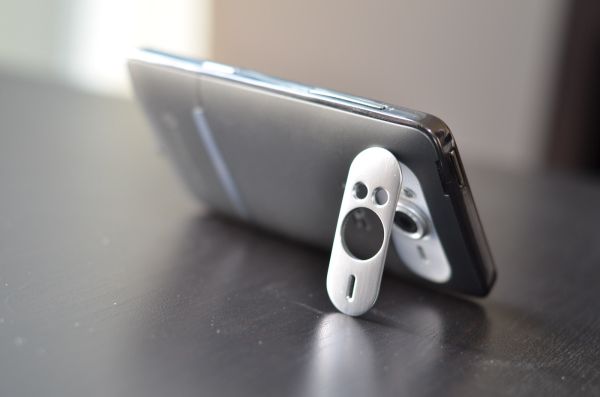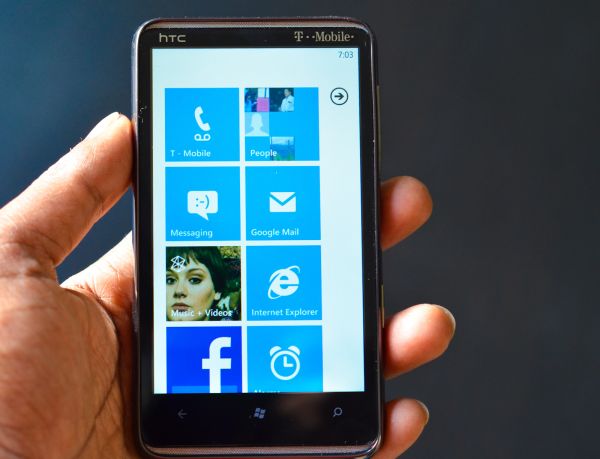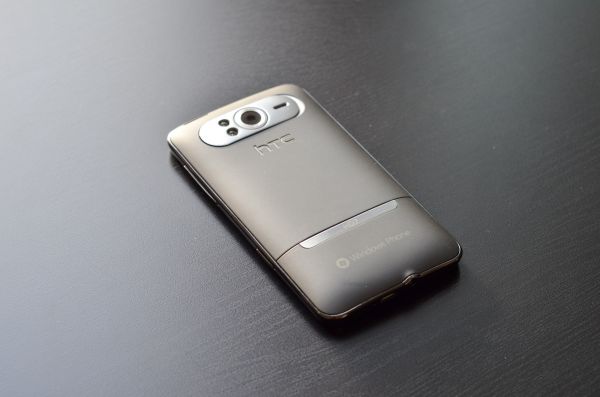HTC HD7: Now With NoDo
by Vivek Gowri on May 12, 2011 6:30 AM EST- Posted in
- Smartphones
- Windows Phone 7
- Snapdragon
- Mobile
- HTC HD7
When Microsoft launched Windows Phone 7 late last year, it was readily evident that they had a solid platform on their hands, but it was missing some critical details. Chief among them? Copy-and-paste, bringing back a frequent grievance from the early iPhone days. The platform’s first update, codenamed “NoDo” (there’s a story behind that), is now out, with copy-paste support in tow, along with much improved application loading and some general performance tune-ups in the UI.
At the same time, we decided to take a look at HTC’s HD7, since it’s been my day-to-day phone for a couple of months now. It’s still the only Windows Phone you’ll find in a T-Mobile store, so it’s worth taking a look at, especially now that a very similar variant is due to hit AT&T in the coming weeks.
Meet the HD7
When HTC launched the HD2 in late 2009, it was one of the most technologically advanced phones on the market, with a 800x480 4.3” display and a 1GHz Qualcomm Snapdragon processor. This was well before everyone had a 1GHz phone—the HD2 was just the second Snapdragon-based device to hit market, after the European Toshiba TG-01, and was the first 1GHz phone on the American market. Unfortunately, for all the amazing hardware, it was saddled with Windows Mobile 6.5. Even with HTC’s advancements to WM (capacitive touch, multitouch, the first implementation of Sense UI) it simply wasn’t a viable platform at the time. A good comparison would be the N8—great hardware running a dead-in-the-water OS.
When Microsoft started releasing details about Windows Phone 7, it became clear that while fully capable of running the new OS, the HD2 would not be getting an upgrade. Microsoft indicated that the button layout did not conform to the guidelines given for WP7 handsets, which was true, but Microsoft really wanted to have a clean break from the previous generation of products, and that left the HD2 in a cold place (officially, at least—XDA and other developers have gotten everything from Froyo to WP7 to Ubuntu and Windows XP running on the HD2). HTC did the next best thing, and relaunched it’s flagship Windows device as the HD7, with 7 indicating it’s status as a WP7 device. In the process, it got a mild ID refresh and a few more features, but overall, it’s very, very similar.
The first noticeable difference is the buttons—the five button array has been replaced by three backlit capacitive buttons—back, Windows, and search, as dictated by the WP7 design guide. The speaker and mic have been expanded to span the width of the device at the top and bottom edges, with an attractive metal grille covering them. The matte plastic on the sides of the phone has been replaced with a dark chrome band, which has an attractive but understated look. It’s much more subtle than normal chrome brightwork.

The curved back of the HD7 is rendered in a mildly rubberized plastic, with a brushed aluminum stand surrounding the camera. The stand, while a clever detail, is not actually that great—like the EVO 4G, it’s prone to tipping over if not on a perfectly level surface, due to the location and shape of the stand itself. I like the Thunderbolt’s stand better, it’s sturdier and works in both portrait and landscape modes. But the biggest problem here is the battery cover. The soft touch plastic is great, but the cover itself feels cheap, and for good reason. The plastic itself is ridiculously thin, and there are large panel gaps—with the battery cover mounted, you can actually see a bit of the SIM card. In addition, the panel gaps let in a lot of dust. It’s a blemish on an otherwise well designed device.
The interesting part hidden in all this is that given HTC’s current lineup, the HD7 feels a little bit last generation. HTC has moved to a very consistent design language across all of it’s devices, as noted by Brian in his Thunderbolt review. It started with the Desire HD, which was an update of the Nexus One/Desire industrial design, and HTC has since expanded the design language to (long list alert!) the Mozart, the Surround, the Trophy, the Thunderbolt, the Sensation, and the Desire S (or the Incredible S for VZW). The HD7 is a holdover from the old days, when HTC had more slab sided designs, with less curves and less metal. Most of the recent HTC designs have basically pointed towards aluminum unibody construction, and the HD7 unashamedly differs from that. I’d expect the next revision of the HD7 to fall much more in line with the rest of HTC’s recent phones, possibly based on the Desire HD chassis.
| Physical Comparison | |||||||||
| HTC HD7 | HTC Surround | LG Optimus 7 | Samsung Focus | Dell Venue Pro | |||||
| Height | 122 mm (4.80") | 119.7 mm (4.71") | 125 mm (4.92") | 122.9 mm (4.84") | 121.0 mm (4.76") | ||||
| Width | 68 mm (2.68") | 61.5 mm (2.42") | 59.8 mm (2.35") | 65 mm (2.56") | 64.4 mm (2.54") | ||||
| Depth | 11.2 mm ( 0.44") | 12.97 mm (0.51") | 11.5 mm (0.45") | 9.9 mm (0.39") | 14.9 mm (0.59") | ||||
| Weight | 162 g (5.71 oz) | 165 grams (5.82 oz) | 157 grams (5.54 oz) | 119 grams (4.2 oz) | 176 grams (6.21 oz) | ||||
| CPU | 1GHz Qualcomm QSD8250 | 1 GHz Qualcomm QSD8250 | 1 GHz Qualcomm QSD8250 | 1 GHz Qualcomm QSD8250 | 1 GHz Qualcomm QSD8250 | ||||
| GPU | Adreno 200 | Adreno 200 | Adreno 200 | Adreno 200 | Adreno 200 | ||||
| RAM | 576MB LPDDR1 (512 system, 64 GPU) | 512 MB LPDDR1 (448 system, 64 GPU) | 512 MB LPDDR1 (448 system, 64 GPU) | 512 MB LPDDR1 (448 system, 64 GPU) | 512 MB LPDDR1 (448 system, 64 GPU) | ||||
| NAND | 16GB integrated | 512 MB integrated, 16 GB (Internal Class 4 microSD) | 16 GB integrated | 8 GB integrated | 8 or 16 GB integrated | ||||
| Camera | 5MP with autofocus, LED flash, 720P video recording | 5 MP with autofocus, LED flash, 720P video recording | 5 MP with autofocus, LED flash, 720P video recording | 5 MP with autofocus, LED flash, 720P video recording | 5 MP with autofocus, LED flash, 720P video recording | ||||
| Screen | 4.3" LCD 800 x 480 | 3.8" LCD 800 x 480 | 3.8" LCD 800 x 480 | 4" Super AMOLED 800 x 480 | 4.1" AMOLED 800 x 480 | ||||
| Battery | Removeable 4.55 Whr | Removable 4.55 Whr | Removable 5.55 Whr | Removable 5.55 Whr |
Removable 5.18 Whr |
||||
At 162 grams (5.7 ounces), the HD7 is a pretty hefty phone, and the size and weight give it a substantial feel in-hand. Battery cover notwithstanding, it feels very well put together and very familiar at the same time. The HD7’s similarities with the EVO and HD2 are not just limited to physical attributes; all three share variants of Qualcomm’s first generation Snapdragon SoC. The GSM-only HD7 has the QSD8250, as with all other WP7-based handsets, to go along with 576MB RAM, 512MB ROM, and a built-in 16GB SD card. It’s no longer cutting edge, but Microsoft is fairly limiting as far as what they allow handset makers to use—you can get a WP7 device with any CPU as long as it’s a 65nm Scorpion, Ford Model T-style. We’ll get to the application performance in a bit, specifically the NoDo update and the performance improvements it brings, but for now, let’s take a look at the display and camera performance.


















44 Comments
View All Comments
VivekGowri - Thursday, May 12, 2011 - link
Not much, other than the NoDo update being delayed from January to April. I very much understand that Mango will cure most, and very close to all, of the fundamental issues with WP7. But it needs to come out sooner. June-July would be preferable, but I'm willing to settle for the October-ish time frame. If it gets pushed back another 2-3 months like NoDo, and Mango devices end up shipping in December-January, Microsoft is screwed. This isn't a question about the OS itself or what Mango will bring, it's a question about how quickly Microsoft needs to iterate and how basically flawless their execution needs to be to catch up within the next 24 months.irsmurf - Thursday, May 12, 2011 - link
Vivek,I had an HTC HD7 and now own a Dell Venue Pro. Thank you for writing such a thorough critique of the state of the Windows Phone 7 OS. I love my phone and while I accept lacking the advanced functionality of iOS and Android, I can do so only because Microsoft's promise to include these components in the next OS update.
You're list WP7's shortcommings, "...3rd party multitasking, decent JavaScript performance, Silverlight, Flash, USB mass storage support, some decent form of IM support, VoIP and video calling, tethering or WiFi hotspot support, file transfers via Bluetooth, and custom ringtones," is the most complete I've seen attached to constructive criticism.
I can't agree more about keeping the OS update cycle shorter than twelve months. Like movie studios, these mobile operating systems futures are only as bright as the next OS update. Microsoft will generate an enormous amount of good will if Mango is delivered ON TIME with its promised features.
VivekGowri - Thursday, May 12, 2011 - link
I went the opposite direction - first the DVP, now the HD7, with a little Android in between. Honest to god, I'm probably dumping the platform for Android again, probably whenever the Sensation comes out. I love the UI, I just really need IM support and better Gmail support.And man oh man, WP7 needs Mango soon. Like, it'd be great if they could get it out in the next five weeks kind of soon, but at this point, I'd settle for September or whenever they said they'd release it. If it ends up three months late again and we see it in December or something...well...to quote Russel Peters, "SOMEbody gonna get a hurt reaaaaaal bad." That somebody will probably be Microsoft.
XMason386 - Thursday, May 12, 2011 - link
Excellent article!So far the only irritating problem I have encountered with the HD7 is finding a holster and arm band that it will fit in easily. I hear that owners of the Droid X and EVO 4G experience similar challenges with 4.3 sized devices. In store accessories are also a bit hard to find because just about everywhere I go, most of the mobile accessories are for iPhones.
I have had this HD7 for 6 weeks now and love it. It's very simple to setup and use daily. The integration with Windows Live, XBOX and Zune is great. I'm not an app hoarder so all the apps I will really use are available.
The battery life is better than I expected and I'm hoping multitasking enhancements do not interfere with power consumption or stability later on.
paulpod - Thursday, May 12, 2011 - link
I like the simple functionality of Windows Phone tiles but the missing functionality and wasted space of the homescreen take this to too much of an extreme.In that first screenshot, above the tiles you could have a signal strength indicator, a ringer setting indicator, a bluetooths conneciton indicator, a location setting indicator, and many more. But instead you have BLANK SPACE. That makes no sense whatsoever. And having to touch something to see indicators is a massive step backward for even the earlies "dumb" phone.
Then look at all the wasted space down the righthand side below the arrow. You could have optional settings switches here (airplane mode on/off, etc,) and smaller quick-launch buttons for apps that do not warrant a full tile and get buried way down the page.
paulpod - Thursday, May 12, 2011 - link
Wish I could edit the typos! *backward from even the earliestVivekGowri - Thursday, May 12, 2011 - link
It's an industrial design thing - it's just cleaner that way. I'm not going to bug Microsoft for the minor UI details, because I know how much they sweated each and every single UX interaction and the thinking that went into it. The UI design is one of the single best things about WP7 in my mind.Belard - Thursday, May 12, 2011 - link
I'm an Android user... and the design of WP7 is a clean and easy look. I wish Android didn't copy Apple so much with its icon layout.While they are called "tiles" on WP7, they are still icon-buttons with interactivity really. But hey, for a main screen on a phone, only 4-8 buttons are needed.
On my Android, I have it mostly clean of buttons... just 8. I wish they were bigger (double size). I still like it over Apple a bit more, which doesn't give you custom desktops.
cj100570 - Thursday, May 12, 2011 - link
The problem with WP7 is that Microsoft is incompetent.VinnyV - Thursday, May 12, 2011 - link
Imagine sitting on your couch in the living room, saying: Xbox Kinect, Skype, call Anand!Then Anand's new Nokia rings (with his custom ringtone of course!) and over his Wifi Internet connection instead of over 3G or 4G or whatever, he sees you on his nice big clear WP8 Nokia screen, sitting on your couch, feeling like the future's finally arrived.
I wouldn't just be worried if I was an Apple or an Android, I'd be worried if I was making my money sending people bills for using my mobile network...